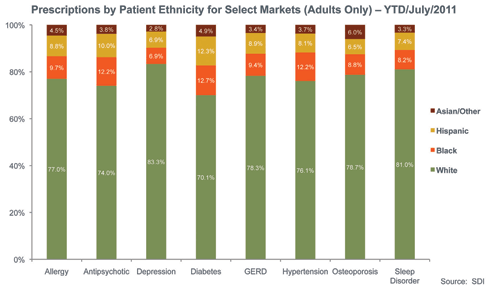In industries such as credit cards or consumer packaged goods, the amount of information collected and analyzed about current and prospective customers is overwhelming. This enables companies to be targeted and efficient in their marketing and customer service initiatives. In the healthcare industry, however, with its protections of patient privacy, knowing the identities of market patients is out of the question (unless they self-identify by enrolling in a marketing or wellness program). What is possible, though, is understanding the characteristics of patients, and how those characteristics affect behavior.
UNDERSTANDING PATIENTS: FIRST EFFORTS
In the early 2000s, the first glimpses of patient-level data gave manufacturers insights previously unavailable. First, the age and gender of patients filling prescriptions could be reported. Audited surveys and primary market research yielded rough ideas of who constituted a market, but this was the first time that market share by these metrics could be calculated accurately. Second, a patient’s past prescription history within a market could be studied. Instead of having to rely on new-prescription trends to identify new-patient activity, patient categories such as new-to-market, switch, add-on, and continuing were introduced. Initially, these new metrics were revolutionary. They helped marketers understand that just a fraction of new prescriptions were filled by actual new-to-brand patients and provided more accurate information to forecast growth. Today, every brand manager should be familiar with these measures. In fact, source-of-business metrics have become the norm, and nearly every pharmaceutical manufacturer includes them in their ongoing monitoring and reporting of market trends. Although these variables are important, they’re only the first steps in understanding who the patients in your market are.
OTHER PATIENT CHARACTERISTICS
Since the early days of patient-level data, the variety and volume of patient characteristics available for study have grown dramatically. By linking healthcare data with other consumer attribute sources, information about the types of patients in healthcare markets now includes demographics (such as ethnicity, education, and wealth), interests, and media preferences—including television program viewing and magazine subscriptions. This isn’t just a case of asserting that knowing more is better. Many of these patient characteristics affect patient behavior and physician treatment decisions. Let’s use patient ethnicity as an example. If all other things were equal, the percentage of prescriptions filled in a market by patients of different ethnicities would be similar to the ethnic makeup of the overall population. But, for obvious reasons like disease prevalence, as well as more nuanced differences, that is far from the case.
When we look at prescriptions filled by adults in some of the industry’s largest markets, we see that during the first 7 months of 2011, the percentage filled by patients of different ethnicities varied (Figure 1). While it’s not surprising that the diabetes and hypertension markets have a higher-than-average percentage of total prescriptions filled by black patients (because the prevalence of these conditions is higher in the black population), knowing exactly what that percentage is and how many prescriptions it accounts for is important. Of the almost 89 million prescriptions filled by adults in the diabetes market from January to July 2011, black patients accounted for 12.7%, or more than 11 million.
STRATEGIC TARGETING
Beyond market sizing by additional patient metrics, looking at how your brand is performing in different patient segments can lead to smarter and more strategic targeting and sales goals. For instance, in the antipsychotic market, where brands compete with each other and only one major generic, brand teams may be looking for market segments where they can expand their business. About three-fourths of the market’s adult prescriptions (74%) were filled by white patients during the first 7 months of 2011. The volume of prescriptions filled by black and Hispanic patients was substantial, though, with more than 2 million prescriptions filled by adults of each ethnicity. Efforts to increase antipsychotic market share among black and Hispanic patients may prove to be worthwhile, particularly because not every brand performed well in these patient segments. For instance, of all antipsychotic prescriptions filled by adults, Seroquel was the most popular, accounting for 33.1% of prescriptions (Figure 2). But among black adults, Seroquel’s market share dropped to 28.5%. Abilify also performed much worse in this population, accounting for 13.6% of antipsychotic prescriptions for black adults compared with 16.7% of prescriptions filled by adults overall. In addition to ethnicity, other patient characteristics can provide segments to target or intelligence that can affect marketing strategies and messages. For instance, a patient’s ability to pay for a prescription, identified by using income and wealth metrics, is important to marketers as they decide when, how, and for whom co-pay assistance may be offered. Education is another metric that provides information on how to find, and approaches to reach, patients. Marketers with brands in the allergy, depression, and sleep disorder markets, which had more than 30% of their prescriptions filled during the first 7 months of 2011 by patients with college or postgraduate degrees, may want to reach and speak to their patients differently than marketers focusing on less-educated patients.
SEGMENT VALUE
In some cases, identifying that patients in a certain group fill a substantial number of prescriptions in your market—and that your brand has room for growth among them—is enough to begin exploring how you could gain more of those patients for your drug. You could identify the geographic areas where there are concentrations of these patients—or pinpoint which physicians or facilities treat the patients you are interested in—to help formulate a sales strategy. Or, you could go one step further and evaluate how valuable these segments of patients potentially are going to be for your brand.
Tracking patient segments over time (either historically or in real time) lets brand teams determine which segments are most persistent and compliant on therapy, and therefore most valuable to a brand. If a brand team’s newly identified targets, such as an ethnic group in which the brand performs poorly, tend to remain on therapy consistently, or at least more consistently than others, this would justify the budget spent to try and acquire them. If these newly identified patients are of lesser value, the return on investment will be much lower. While not every metric is important in each market, we have found that many patient characteristics do influence behavior and, ultimately, brand performance. Through advanced techniques it is possible to identify which patient characteristics have the most impact on patients and more often result in attractive behaviors.
FIGURE 1:

FIGURE 2:






